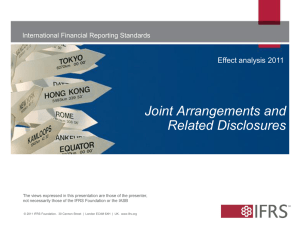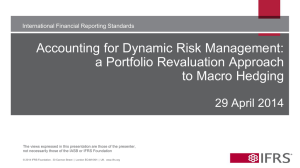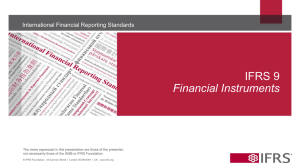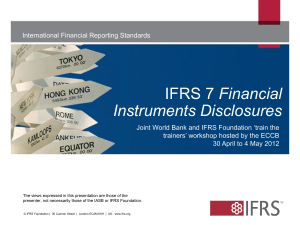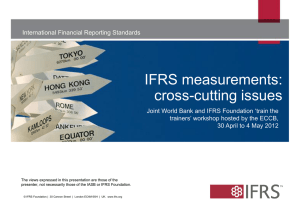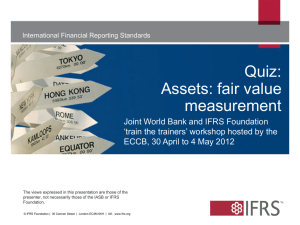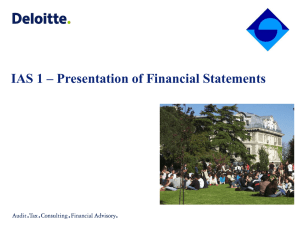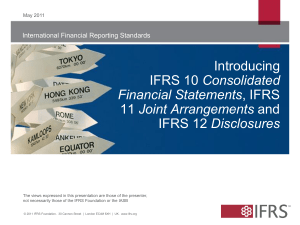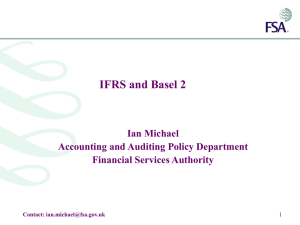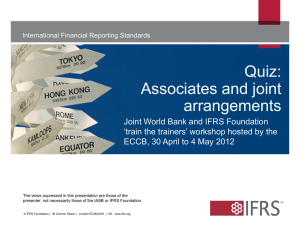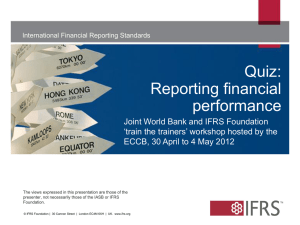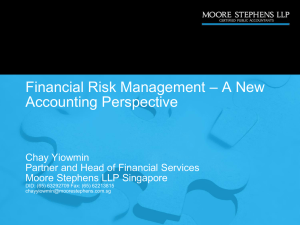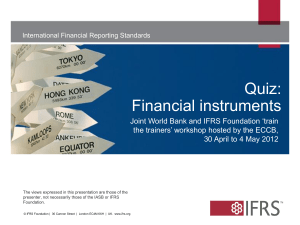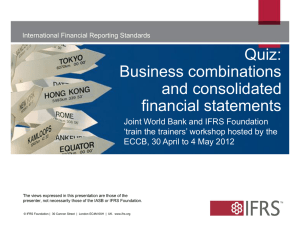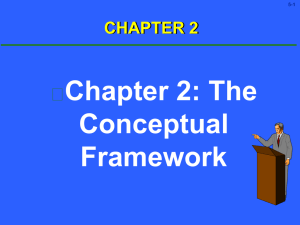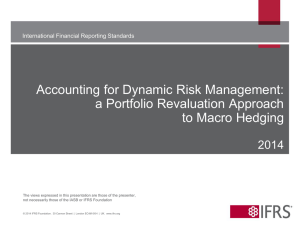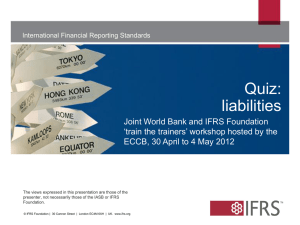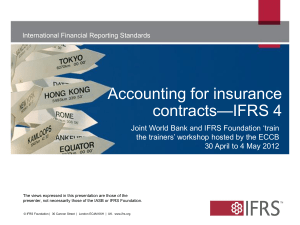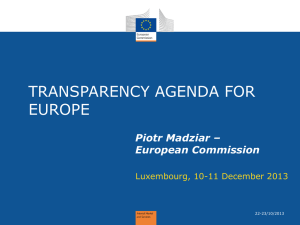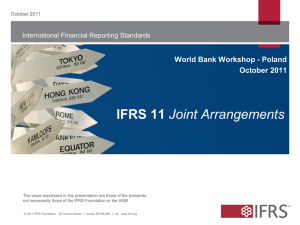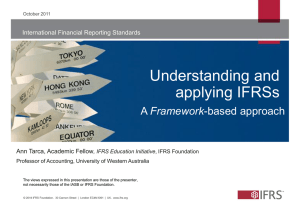Slides
advertisement
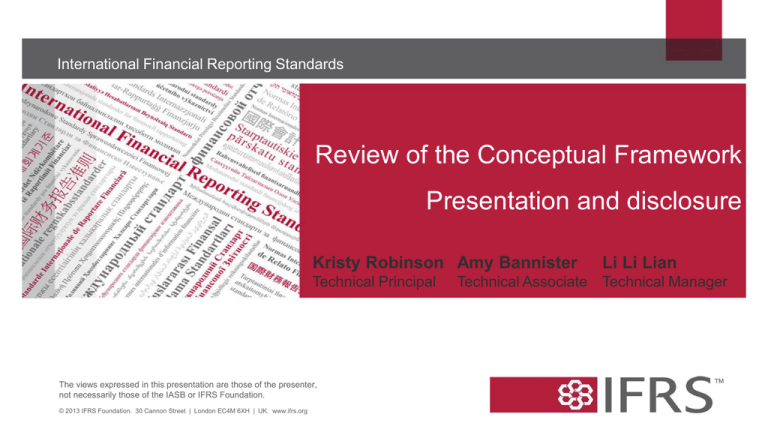
International Financial Reporting Standards Review of the Conceptual Framework Presentation and disclosure Kristy Robinson Amy Bannister Technical Principal The views expressed in this presentation are those of the presenter, not necessarily those of the IASB or IFRS Foundation. © 2013 IFRS Foundation. 30 Cannon Street | London EC4M 6XH | UK. www.ifrs.org Li Li Lian Technical Associate Technical Manager Before we start… • You can download the slides by clicking on the button below the slides window • To ask a question, type into the designated text box on your screen and click submit • A recording of the webcast will be available after the presentation at http://go.ifrs.org/Conceptual-Framework • The views expressed are those of the presenters, not necessarily those of the IASB or IFRS Foundation © IFRS Foundation. 30 Cannon Street | London EC4M 6XH | UK. www.ifrs.org 2 Project overview Project objectives • Not a fundamental re-think • Focus on weaknesses that have given problems in practice • Filling in gaps, and updating and improving existing guidance Discussion Paper objectives • Preliminary views • Starting point for further discussion and consultation • Seeking your views by 14 January 2014 Project consequences • New Conceptual Framework will not override existing IFRSs © IFRS Foundation. 30 Cannon Street | London EC4M 6XH | UK. www.ifrs.org 3 Overview Objective of this webinar • Describe and explain the concepts in the Discussion Paper on presentation and disclosure What we will cover • • • • What ‘presentation’ and ‘disclosure’ mean The primary financial statements The notes to the financial statements Form of disclosure and presentation requirements Questions © IFRS Foundation. 30 Cannon Street | London EC4M 6XH | UK. www.ifrs.org 4 What do ‘disclosure’ and ‘presentation’ mean? Disclosure Presentation 5 “the process of providing useful financial information about the reporting entity to users” “the disclosure of financial information on the face of an entity’s primary financial statements” © IFRS Foundation. 30 Cannon Street | London EC4M 6XH | UK. www.ifrs.org Primary financial statements The Discussion Paper identifies the primary financial statements as: Statement of financial position Statement(s) of profit or loss and OCI Statement of changes in equity Statement of cash flows 6 No primary financial statement is more important than the other primary statements. They should be looked at together. Objective of the primary financial statements 7 “to provide summarised information about recognised assets, liabilities, equity, income, expenses, changes in equity and cash flows that has been classified and aggregated in a manner that is useful to users of financial statements in making decisions about providing resources to the entity” Disclosure • recognised economic resources and claims • changes to those resources and claims • how efficiently and effectively the entity’s management and governing board have discharged their responsibilities to use the entity’s resources © IFRS Foundation. 30 Cannon Street | London EC4M 6XH | UK. www.ifrs.org Classification and aggregation Classification • The sorting of items based on shared qualities Aggregation • The adding together of individual items within those classifications © IFRS Foundation. 30 Cannon Street | London EC4M 6XH | UK. www.ifrs.org 8 Line items • Present useful summarised information Determined by entity, but IASB may decide to require a particular line item to be presented Offsetting 9 • Offsetting will generally not provide the most useful information because it combines dissimilar items, eg: – assets & liabilities – income & expenses – cash receipt & cash payments Disclosure • The IASB may choose to require offsetting when: – provides a faithful representation of items – necessary on cost-benefit grounds © IFRS Foundation. 30 Cannon Street | London EC4M 6XH | UK. www.ifrs.org The notes to the financial statements Objective • To supplement the primary financial statements by providing additional useful information about: • the assets, liabilities, equity, income, expenses, changes in equity and cash flows of the entity; and • how efficiently and effectively the entity’s management and governing board have discharged their responsibilities to use the entity’s resources Disclosure Scope 10 • Types of information • Forward-looking information © IFRS Foundation. 30 Cannon Street | London EC4M 6XH | UK. www.ifrs.org Scope of the notes to the financial statements Type of information (scope) 11 Examples • • Information about subsidiaries, associates, parent, etc. Business model Amounts recognised in the primary financial statements • • Disaggregation of line items in primary financials Relationship between line items Unrecognised assets or liabilities • Description of unrecognised assets or liabilities and why they have not been recognised Risks • • Types of financial risk How the entity has managed those risks Methods, assumptions and judgements • • Accounting policies Alternative measurements Reporting entity Disclosure © IFRS Foundation. 30 Cannon Street | London EC4M 6XH | UK. www.ifrs.org Materiality 12 • Existing Conceptual Framework has a materiality concept • The IASB’s preliminary view is that that concept of materiality is clearly described in the existing Conceptual Framework – not adding to or amending that description • Another project on the IASB’s agenda looking at how the concept of materiality is applied Form of disclosure and presentation requirements Disclosure objectives • Each Standard should have a clear disclosure objective • Enables entities to determine whether the specified information is material for that entity Electronic format • When developing requirements IASB may need to consider the impact of technology, eg: • Flexibility in order and level of aggregation • Consistent use of terminology, total and subtotals Communication principles • Disclosure as a form of communication • See next slide 13 Communication principles 14 • Seek to promote the disclosure of entity-specific useful information • Result in disclosures that are clear, balanced and understandable • Enable an entity to organise disclosures to highlight important information • Linked to understand the relationship in the financial statements • Not result in duplication of the same information • Seek to optimise comparability without compromising the usefulness Disclosure Initiative 15 • Disclosure project in parallel with Conceptual Framework project. Projects inform each other – some overlap Materiality Conceptual Framework Objective of notes to FS Communication principles Form of disclosure requirements Disclosure Initiative Questions © IFRS Foundation. 30 Cannon Street | London EC4M 6XH | UK. www.ifrs.org 16 More information • Discussion Paper http://go.ifrs.org/DP-Conceptual-Framework-July-2013 – Comments to be received by 14 January 2014 • Snapshot http://go.ifrs.org/Snapshot-DP-Conceptual-Framework-2013 • Existing Conceptual Framework http://eifrs.ifrs.org/eifrs/bnstandards/en/2013/conceptualframework.pdf • Conceptual Framework website http://go.ifrs.org/Conceptual-Framework © IFRS Foundation. 30 Cannon Street | London EC4M 6XH | UK. www.ifrs.org 17 Other webcasts 18 Date Topic Tuesday 3 September 2013 Definitions of assets and liabilities and recognition criteria Friday 13 September 2013 Profit or loss and other comprehensive income (OCI) Friday 27 September 2013 Definition of equity and distinction between liability and equity elements Measurement Wednesday 2 October 2013 Thursday 10 October 2013 Tuesday 22 October 2013 Monday 25 November 2013 © IFRS Foundation. 30 Cannon Street | London EC4M 6XH | UK. www.ifrs.org Guidance on liability definition—obligations conditional on entity’s future actions Objective and Qualitative Characteristics Presentation and disclosure
